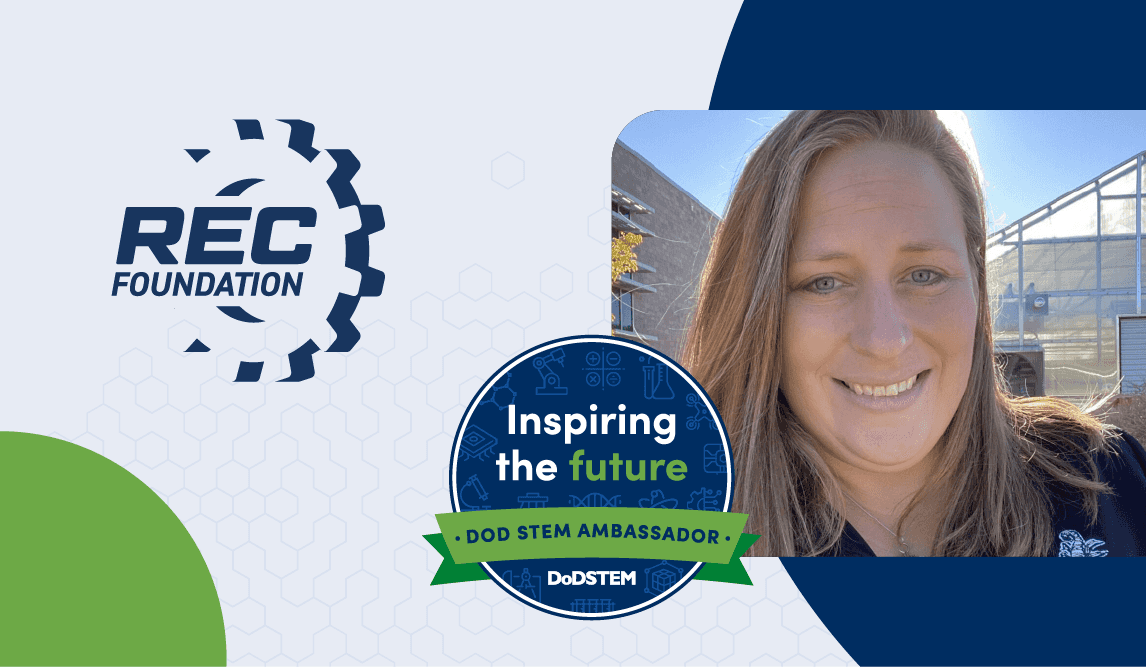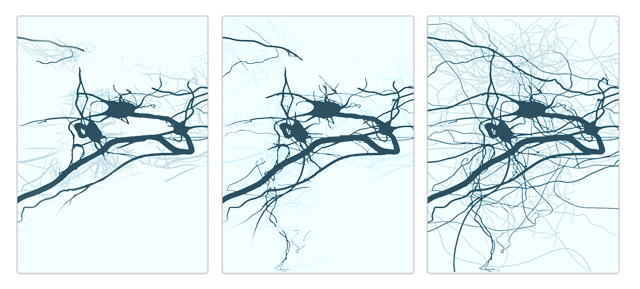Helping Students Build a STEM Identity
15 Nov 2024
DoD STEM Ambassador Gretchen Greer Explains the Importance of Helping Students Build a STEM Identity
DoD STEM Ambassador Gretchen Greer reflects on her STEM journey and shares several questions to increase understanding of how a STEM identity develops and why it is important.

The following was written by Gretchen Greer, a high school CTE teacher and DoD STEM Ambassador. DoD STEM Ambassadors work with the Defense STEM Education Consortium (DSEC) to advance STEM outreach for students who are underrepresented in STEM or military connected. Greer was selected by the Robotics Education & Competition (REC) Foundation as their DoD STEM Ambassador for the 2023-2024 school year.
At a recent workshop for secondary teachers, I was asked, “What is your STEM story?” I was shocked when the person next to me said she did not have one! I countered in disbelief, saying that I was sure she did! When I asked about her interests and experiences, I learned about her previous career in financial management in the public sector. She now teaches math and art. In my opinion, she absolutely is a STEM educator, even though she didn’t see herself in that role.
Similar to how all teachers employ reading strategies, all teachers should begin to see themselves as STEM educators. This viewpoint will help foster development of our students’ STEM skills through transdisciplinary content. I am sure that individual STEM journeys begin before and continue long after our time in the traditional education system ends. Our STEM identity continues to evolve throughout our lives.
The Early Years
“Why?” is a common question from children, who are naturally inquisitive as they observe, play, develop language, learn, and grow, often with high levels of imagination and through trial and error. Former NASA engineer and YouTube sensation Mark Rober, in his keynote speech at the 2024 National Science Teachers Association Conference, credits his mom as his first STEM teacher. Parents have a huge impact on cultivating curiosity and exposing kids to STEM. For me, nature was my most-welcome playmate as I built cardboard mansions on a log bridge over a creek, camped, hiked, swam, and helped my grandpa at his dairy farm. I spent summers on lakes in the Adirondacks, picking berries, tending a garden, planting Christmas trees, chopping wood, making maple syrup, and learning to ski. Our family took road trips to national parks. I spent lots of time playing outside with friends. My parents encouraged me to be outside, and my love of nature greatly influenced my choice to pursue an environmental science degree.
For some children, teachers are more influential than parents. Teachers introduce children to the world at large in graduated increments from within the safeguards of public schools or other youth organizations. When time is limited, every minute matters. Check out this equation:
- Full-time teachers work a 180-day contract.
- STEM classes are 52 minutes long.
- 180 days x 52 minutes
- = 9,360 minutes, or 156 hours spent learning each school year
Time may seem limitless during the school year, but it actually is a very finite amount. Are you making the most of the time you have with your students? As a parent and teacher, I struggle with this question even more now that my eldest has left the nest, but I take comfort in knowing that our family time and values were the best foundation I was able to provide. My husband and I agreed early on to encourage our children to spend time with and learn about animals, offer lots of time outside, and let each child follow their own interests. Our eldest truly enjoyed tinkering, which turned out to be a natural segue into robotics and drones.
A Time for Diversification
What are your priorities and goals for your time with your kids? Also, what do you want to do with your life? I had an epiphany just before completing my bachelor’s degree when I was working as an outdoor educator and teaching science to various school groups. I was complimented for being a pretty good teacher and was told, “You should do this full time.” We hadn’t really been exposed to future career possibilities during our classes. At the time I was very busy and overwhelmed with all aspects of student life, and this offhand suggestion was a lightbulb moment that changed my career trajectory! The convergence of experiential learning in an authentic work or service environment allows students to apply their knowledge instead of being passive learners. These opportunities allow kids to visualize themselves as part of a specific workforce, which can increase their confidence and help them decide if this type of work captivates their interest.
What careers and applications of content are we sharing with our students? This question plagued me as a new teacher in the early 2000s. I moved directly from college to teaching, never leaving the education pipeline. Teaching was challenging enough, and I couldn't fathom how to teach something I didn’t know. Flash forward: I soon learned about the abundant resources, curricula, and supplemental sites to support students as they explore the possibilities of STEM careers! Following are some examples:
- DoD Civilian Careers
- O*NET OnLine
- BigFuture
- Armed Services Vocational Aptitude Battery (ASVAB) Career Exploration Program
- My Next Move
Learning something new is not always easy. My husband has been a volunteer fireman since he was a teenager. Twenty years later he decided to become an EMT. At first, he thought this would be like his previous training. But when he brought the textbook home, he realized he had to read it and really learn so much new information. This was a shock because previously he could attend class, listen, and practice, and everything was fine. He soon learned firsthand about the adage “FAIL is a First Attempt In Learning.” Failing grades on EMT tests generally lead to immediate attrition. During the first month, my husband realized that not only did he need to go to class and practice, but he also needed to listen to the audiobook, take notes, utilize practice quizzes, and review everything multiple times before each test. If the topic is something a student wants to learn or is a prerequisite for future classes, failing grades should not be the sole reason for giving up.
Evolving Brain Power
How can you support this student’s success? And, what’s next? Our brains are absolutely amazing! Neuroscientific discoveries during the past 10 to 15 years have been incredible and show how everyone, even adults, can continue to learn new things and create new synaptic connections. Check out these images showing growth over 2 weeks and 2 months of neuron stimulation.

Image source: https://www.cognifit.com/brain-plasticity-and-cognition
Along these lines, after teaching for 10 years I was more than ready for a change. I noticed a pattern of students struggling with math. I learned that passing Algebra 1 is just as important as being able to read by third grade in terms of predicting future success, so I decided to switch from teaching science to teaching Algebra 1. I was not certified to teach math at the time, so I had a lot to learn.
I spent the next 10 years teaching math, which required less lesson preparation time. This meant I had time to help my children learn more about animals. They joined 4-H and started raising sheep, before moving into breeding sheep, horses, chickens, cows, dogs, and guard animals. They also got into judging livestock. My eldest son liked building robots and flying drones, so I agreed to replace a physics teacher who was retiring. This dovetailed nicely into supporting my son and his friends in competitive robotics. To my surprise, while watching them compete I witnessed their growth in science knowledge, leadership, perseverance, communication, teamwork, and other soft skills. It doesn’t matter that I’m not an expert with any of these topics—I learned right along with my kids! I helped facilitate learning and finding resources when we had questions or got stuck. We all made progress and have truly enjoyed the journey.
Our life stories are interwoven with milestones that anchor our individual STEM stories. Currently competitive robotics and animals are threads that connect my professional life with being a mom of three active boys. As I continue to evolve and circle back to science, I’m not sure what the future may hold for me next. Regardless of what that may turn out to be, I’m always asking myself: in what ways can I positively impact others? Because now, I’m really curious: what is your STEM story?
About REC Foundation
The Robotics Education & Competition (REC) Foundation, based in Greenville, Texas, develops robotics engineering programs for students with the goal of increasing overall student interest and involvement in STEM subject areas. With DSEC support, the REC Foundation will support schools in the Gulf Coast region of the United States (Alabama, Louisiana, Mississippi and Texas) as well as the mid-west region (Illinois, Kansas, Missouri) to field 110 teams and compete in the REC Foundation’s Aerial Drone Competition. The teams will progress through a program covering autonomous and driver skills, 3-D printing and computer-aided drawing, in addition to multiple coding platforms including Python, JavaScript, MATLAB and more.
About DoD STEM and Defense STEM Education Consortium
Defense STEM Education Consortium (DSEC) is a collaborative partnership of STEM-focused organizations dedicated to addressing and prioritizing our nation's STEM talent. DSEC aims to broaden STEM literacy and develop a diverse and agile workforce with the technical excellence to defend our nation. Through strategic investment in STEM education and outreach activities, the effort will provide students with more exposure to educational and career opportunities as well as DoD research. DSEC is led on behalf of DoD STEM by RTI International.